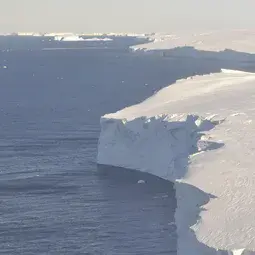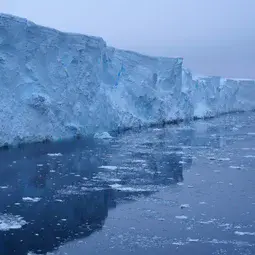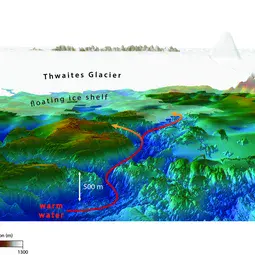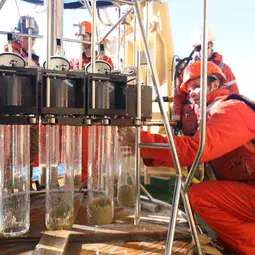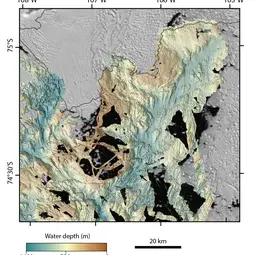Deep channels link ocean to Antarctic glacier
9 September 2020
Newly discovered deep seabed channels beneath Thwaites Glacier in West Antarctica may be the pathway for warm ocean water to melt the underside of the ice. Data from two research missions, using aircraft and ship, are helping scientists to understand the contribution this huge and remote glacier is likely to make to future global sea level rise.
Researchers from the UK- and US-led International Thwaites Glacier Collaboration (ITGC) collected data from the glacier and adjoining Dotson and Crosson ice shelves during January–March 2019. While one team of international researchers collected airborne data flying over the glacier and ice shelf in a British Antarctic Survey Twin Otter aircraft, the other mapped the sea floor at the ice front from the US Antarctic Program icebreaker RV Nathaniel B Palmer.
Two research papers published this week in the European Geosciences Union’s journal The Cryosphere describe the discovery. Thwaites Glacier covers 192,000 square kilometres (74,000 square miles) – the size of Great Britain or the US state of Florida – and is particularly susceptible to climate and ocean changes.
Accelerating ice loss
During the past 30 years, the overall rate of ice loss from Thwaites and its neighbouring glaciers has increased more than 5-fold. Already, ice draining from Thwaites into the Amundsen Sea accounts for about 4 percent of global sea-level rise. A run-away collapse of the glacier could lead to a significant increase in sea levels of around 65 cm (25 inches), and scientists want to find out how quickly this could happen.
Lead author Tom Jordan, an aero-geophysicist at British Antarctic Survey (BAS), who led the airborne survey, says:
“It was fantastic to be able to map the channels and cavity system hidden beneath the ice shelf; they are deeper than expected – some are more than 800 metres deep. They form the critical link between the ocean and the glacier. The offshore channels, along with an adjacent cavity system, are very likely to be the route by which warm ocean water passes underneath the ice shelf up to the grounding line, where the ice meets the bed.”
Dave Porter at Columbia University’s Lamont Doherty Earth Observatory, who flew over Thwaites Glacier for the airborne survey, says:
“Flying over the recently-collapsed ice tongue and being able to see first-hand the changes occurring at Thwaites Glacier was both awe inspiring and disconcerting, but also gratifying to know the airborne data we were collecting would help reveal the hidden structures below.”
A clear view for the first time
Exceptional sea-ice breakup in early 2019 enabled the team on the RV Nathaniel B Palmer to survey more than 2000 square kilometres of sea floor at the glacier’s ice front. The area surveyed had previously been hidden beneath part of the floating ice shelf extending from Thwaites Glacier, which broke off in 2002, and in most subsequent years the area was inaccessible due to thick sea-ice cover. The team’s findings reveal the sea floor is generally deeper and has more deep channels leading towards the grounding line under the ice shelf than was previously thought.
Lead author Kelly Hogan is a marine geophysicist at BAS. She was part of the team surveying the seabed. She says:
“We found the coastal sea floor, which is incredibly rugged, is a really good analogue for the bed beneath the present-day Thwaites Glacier both in terms of its shape and rock type. By examining retreat patterns over this sea-floor terrain, we will be able to help numerical modellers and glaciologists in their quest to predict future retreat.”
“This research has filled a critical data gap. Together, the new coastal sea floor maps and the cavity maps track the deep channels for more than 100 km to where the glacier sits on the bed. For the first time we have a clear view of the pathways along which warm water can reach the underside of the glacier, causing it to melt and contribute to global sea-level rise.”
More information
Citations: Hogan, K. A., Larter, R. D., Graham, A. G. C., Arthern, R., Kirkham, J. D., Totten Minzoni, R., Jordan, T. A., Clark, R., Fitzgerald, V., Wåhlin, A. K., Anderson, J. B., Hillenbrand, C.-D., Nitsche, F. O., Simkins, L., Smith, J. A., Gohl, K., Arndt, J. E., Hong, J., and Wellner, J.: Revealing the former bed of Thwaites Glacier using sea-floor bathymetry: implications for warm-water routing and bed controls on ice flow and buttressing, The Cryosphere, 14, 2883–2908, https://tc.copernicus.org/articles/14/2883/2020/, 2020.
Jordan, T. A., Porter, D., Tinto, K., Millan, R., Muto, A., Hogan, K., Larter, R. D., Graham, A. G. C., and Pade, J. D.: New gravity-derived bathymetry for the Thwaites, Crosson, and Dotson ice shelves revealing two ice shelf populations, The Cryosphere, 14, 2869–2882, https://doi.org/10.5194/tc-14-2869-2020, 2020.
Additional media images available at: ftp://ftp.nerc-bas.ac.uk/pub/photo/Thwaites-Glacier/PR_Sept_2020/ (login as ‘guest’).
Text written by Athena Dinar, Senior Communications Manager, British Antarctic Survey.
All EGU journal articles are open access. In published articles please make reference to The Cryosphere and include a link to the journal website: https://www.the-cryosphere.net/ or the article(s) listed above.
The International Thwaites Glacier Collaboration (ITGC) is a five-year, $50 million joint U.S. and U.K. mission to learn more about Thwaites Glacier, its past, and what the future may hold. Significant contributions to the research are also coming from Sweden, Germany, and South Korea. The ultimate goal of the project is to predict how much Thwaites Glacier will contribute to global sea-level rise, and how soon a transition to more rapid ice retreat might occur. ITGC is funded by the U.S. National Science Foundation (NSF) and U.K. Natural Environment Research Council (NERC).
Contact
Researchers
Dr Kelly Hogan
British Antarctic Survey
Email kelgan@bas.ac.uk
Dr Tom Jordan
British Antarctic Survey
Email tomj@bas.ac.uk
Press officers
Terri Cook
European Geosciences Union
Munich, Germany
Email media@egu.eu
Athena Dinar
Senior Communications Manager
British Antarctic Survey
Email amdi@bas.ac.uk
Phone +44 (0) 7909 008516
Links
- Hogan et al. paper
- Jordan et al. paper
- Journal – The Cryosphere
- International Thwaites Glacier Collaboration

